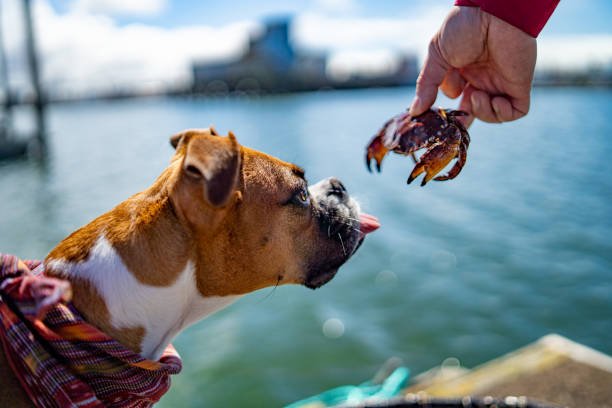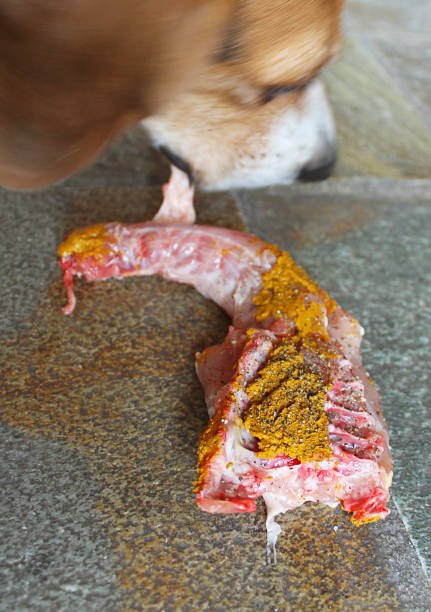Can Dogs Eat Crab? Have you ever wondered if your canine companion can indulge in the delectable world of crab? Crab, with its rich taste and succulent texture, is a delicacy enjoyed by many around the globe.
But what about our furry friends? Can dogs eat crab? This seemingly simple question opens the door to a complex realm of dietary considerations and potential health risks for our beloved pets.

In a world where our dogs are more than just pets – they’re family – understanding their dietary needs and limitations is crucial. We pamper them with love, toys, and treats, but ensuring their well-being goes beyond the basics of shelter and play. Their diet, in particular, requires careful attention to guarantee they lead healthy, fulfilling lives.
Table of Contents
Can Dogs Eat Crab? Exploring the Nutritional Landscape
Is crab safe for dogs?
This common query often leaves pet owners curious yet cautious. It’s natural to want to share our culinary delights with our furry friends, but understanding the intricacies of their dietary needs is paramount. So, can dogs indulge in the sumptuous world of crab? Let’s dive deep into the nutritional facts, potential benefits, and drawbacks to answer this question comprehensively.
Nutritional Profile of Crab
Crab, a seafood delicacy enjoyed by humans worldwide, offers a unique nutritional profile. It’s packed with essential nutrients that make it a tempting treat, even for our canine companions. Let’s break down the nutritional facts of crab in a concise table:
| Nutrient | Amount per 100 g of cooked crab |
|---|---|
| Calories | 97 kcal |
| Protein | 19.4 g |
| Fat | 1.5 g |
| Carbs | 0 g |
| Fiber | 0 g |
| Vitamin B12 | 11.5 mcg |
| Copper | 1.2 mg |
| Selenium | 40.2 mcg |
| Zinc | 7.6 mg |
| Folate | 52 mcg |
| Vitamin C | 4.6 mg |
Crab meat stands out for its high-quality protein content, which is vital for your dog’s muscle development and overall health. Additionally, the presence of Omega-3 fatty acids in crab can contribute to a healthy coat and skin, enhancing the natural sheen of your dog’s fur. Moreover, crab meat is a rich source of Vitamin B12, crucial for the formation of red blood cells, and minerals like zinc and copper, which play essential roles in various bodily functions.
The Pros and Cons of Feeding Crab to Dogs

As enticing as crab sounds in terms of nutrition, it’s not without its pitfalls when it comes to dogs. While the protein and nutrient content is impressive, there are certain drawbacks that every dog owner must be aware of.
Pros:
- High-Quality Protein: Crab meat contains a substantial amount of protein, supporting your dog’s muscle growth and repair.
- Omega-3 Fatty Acids: These healthy fats in crab promote a glossy coat and supple skin, enhancing your dog’s overall appearance.
- Vitamins and Minerals: Crab is a rich source of essential vitamins like B12 and minerals like zinc and copper, contributing to your dog’s overall well-being.
Cons:
- Bacterial Contamination: Improperly prepared crab can harbor harmful bacteria or toxins, leading to food poisoning in dogs.
- Choking Hazard: The hard shell of the crab can pose a choking hazard or cause intestinal blockage if ingested, which can be life-threatening for dogs.
Crab: A Complement, Not a Replacement
While crab does offer valuable nutrients, it’s imperative to recognize that it should complement your dog’s primary diet, not replace it entirely. Dogs require a balanced and specially formulated diet to meet their nutritional needs. Crab, when given as an occasional treat, can add variety to their diet and provide certain health benefits. However, moderation and careful preparation are key to ensuring a positive experience for your furry friend.
In summary, while dogs can enjoy crab meat in moderation, it’s essential to be mindful of the risks associated with bacterial contamination and the potential hazards of the crab’s shell. By following the guidelines mentioned in the previous sections, you can safely introduce crab as an occasional treat, enhancing your dog’s culinary experiences while prioritizing their health and well-being. Stay tuned as we further explore the nuances of crab consumption for dogs, ensuring you have all the information needed to make responsible decisions for your canine companion’s diet.
Understanding the Right Amount: How Much Crab Can Your Dog Safely Consume?
Now that we’ve explored the nutritional wonders and potential risks associated with crab consumption for dogs, the question that naturally arises is: How much crab can a dog eat? The adage “everything in moderation” holds particularly true in the realm of canine culinary adventures. While crab can offer some health benefits, overindulgence can tip the scales toward potential hazards. Let’s delve into the details of portion control, preparation, and factors that influence the ideal serving size for your canine companion.
Moderation is Key
When it comes to treating your dog to crab, the golden rule is moderation. Treats, including crab, should never constitute more than a certain percentage of your dog’s daily calorie intake. Overindulgence can lead to an imbalance in their diet, potentially causing digestive issues and other health concerns. Therefore, it’s crucial to incorporate crab judiciously, ensuring it complements their regular meals without overshadowing the nutritional balance.
Starting Small and Observing Reactions
As a responsible pet owner, it’s wise to start with a small piece of crab and observe your dog’s reaction before offering more. Just like humans, dogs can have unique dietary sensitivities. By introducing crab in small quantities, you can assess how your dog’s digestive system responds. If your furry friend shows any signs of discomfort, such as upset stomach or unusual behavior, it’s a clear indication that crab might not be the ideal treat for them.
Proper Preparation Matters
How you prepare crab for your dog significantly influences its safety and palatability. As reiterated before, always ensure the crab is thoroughly cooked. Cooking not only enhances its flavor but also kills harmful bacteria, making it safer for your dog to consume. Additionally, it’s imperative to remove the shell and any sharp parts completely. This meticulous preparation minimizes the risk of choking, oral injuries, or intestinal blockages, ensuring your dog’s safety during their culinary adventure.
Consider Your Dog’s Size and Breed
The appropriate serving size of crab can vary based on your dog’s size and breed. Larger dogs may tolerate a slightly larger portion compared to smaller breeds without adverse effects. For instance, a Great Dane might handle a bit more crab than a Chihuahua. It’s essential to adjust the portion size according to your dog’s individual characteristics. A general rule of thumb is to provide a portion that aligns with your dog’s weight, ensuring it doesn’t exceed a certain percentage of their daily caloric intake.
Appropriate Serving Sizes Based on Weight
To provide a rough guideline, here’s an approximate breakdown of appropriate crab serving sizes based on your dog’s weight:
- Small Dogs (Up to 20 lbs): A teaspoon to a tablespoon of crab meat.
- Medium Dogs (20-50 lbs): One to two tablespoons of crab meat.
- Large Dogs (50-100 lbs): Two to three tablespoons of crab meat.
- Giant Breeds (Over 100 lbs): Three to four tablespoons of crab meat.
Always remember that these are general guidelines, and observing your dog’s individual response is paramount. If you notice any adverse reactions or changes in behavior after introducing crab, it’s essential to consult your veterinarian promptly.
In summary, while dogs can indeed enjoy the delectable taste of crab, the key lies in responsible portions and careful observation. By adhering to these guidelines and being mindful of your dog’s unique needs, you can ensure that their culinary adventures remain both delicious and safe. Stay tuned as we further explore the world of canine nutrition, providing you with essential insights to enrich your dog’s diet while prioritizing their well-being.
Understanding the Risks: Potential Reactions and Hazards of Feeding Crab to Dogs
While the prospect of treating your dog to a delectable seafood experience might seem enticing, it’s vital to recognize the potential risks associated with feeding crab to dogs. As responsible pet owners, being aware of these risks can make all the difference in ensuring your canine companion’s well-being. Let’s delve into the possible reactions and hazards linked to indulging your dog in this seafood delight.
Food Allergies and Intolerance
Just like humans, dogs can develop allergies to certain foods, and crab is no exception. Food allergies in dogs often manifest as itching, swelling, hives, or gastrointestinal distress. While some dogs might tolerate crab without any issues, others could exhibit signs of food intolerance, especially if they haven’t been exposed to seafood before. It’s crucial to observe your dog closelyafter introducing crab to their diet.
Short-Term Signs of Food Intolerance
In cases of food intolerance, dogs might experience immediate adverse reactions after consuming crab. Gastrointestinal distress, including vomiting, diarrhea, or abdominal pain, could indicate a negative response. If your dog exhibits any of these symptoms shortly after ingesting crab, it’s essential to consult your veterinarian promptly.
Potential Hazards in Crab Components
Beyond allergies, specific components of crab can pose hazards to dogs. For instance, the high sodium content in some crab preparations can lead to increased thirst and urination. Excessive sodium intake can strain your dog’s kidneys and potentially lead to long-term health issues. Additionally, if crab is seasoned with ingredients like garlic or onion, which are toxic to dogs, it can cause severe complications, including damage to red blood cells and gastrointestinal distress.
Watching Out for Allergic Reactions
When introducing crab to your dog’s diet, it’s crucial to be vigilant for signs of allergic reactions. These can include itching, swelling, difficultybreathing, or even anaphylaxis in severe cases. Allergic reactions can occur even if your dog has consumed crab without issues in the past. Each exposure to a potential allergen increases the risk of a heightened reaction, emphasizing the need for caution and observance.
Signs and Symptoms of Adverse Reactions
Being able to identify signs and symptoms of adverse reactions in dogs is essential. Keep an eye out for the following indicators:
- Itching and Scratching: Excessive itching, licking, or scratching, especially around the face and paws.
- Swelling: Swollen face, lips, or eyelids.
- Difficulty Breathing: Labored breathing, wheezing, or coughing.
- Gastrointestinal Distress: Vomiting, diarrhea, or signs of abdominal discomfort.
- Anaphylaxis: Severe reactions can lead to collapse, loss of consciousness, and difficulty breathing. Anaphylaxis requires immediate emergency veterinary care.
In conclusion, while crab can offer potential health benefits to dogs, it’s imperative to recognize and mitigate the associated risks. Being aware of the signs of food intolerance and allergic reactions is crucial for ensuring your dog’s safety. By carefully monitoring your dog’s response to crab consumption, you can make informed decisions about including this seafood treat in their diet. Stay tuned as we continue our exploration, providing you with valuable insights to enhance your dog’s culinary experiences while prioritizing their health and happiness.
Enhancing Your Dog’s Culinary Experience: Creative Ways to Introduce Crab
Now that we’ve explored the potential health benefits and associated risks of feeding crab to your dog, let’s discuss the exciting realm of culinary creativity. Making your dog’s dining experience enjoyable not only nourishes their body but also nurtures their happiness. Fortunately, there are various delightful ways to introduce crab into your dog’s diet, ensuring a flavorful and enticing mealtime. Let’s uncover the art of incorporating crab into your dog’s menu, making it a delightful culinary adventure.

Feeding Crab to Your Dog: Exploring Creative Options
Crab can be introduced to your dog’s diet in various forms, each offering a unique dining experience. Here are some creative ways to incorporate crab into your dog’s meals:
- Fresh or Frozen Treats: Offer small, cooked crab pieces as refreshing treats, especially on warm days. You can freeze the crab meat in ice cube trays for a cool and soothing snack during the summer months.
- Food Topper or Mixer: Mix cooked crab meat into your dog’s regular food. The aroma and taste of crab can elevate the overall meal, making it more enticing and enjoyable.
- Homemade Treats: Get creative in the kitchen by preparing homemade crab treats for your dog. You can bake crab and sweet potato dog biscuits or create crab-filled Kong toys for an interactive and tasty playtime treat.
- Crab-Stuffed Toys: Invest in treat-dispensing toys and stuff them with a mixture of crab and your dog’s favorite vegetables. This interactive feeding method not only provides mental stimulation but also rewards your dog with bursts of crab flavor.
- Crab Broth: Prepare a simple crab broth by boiling crab shells in water. Strain the liquid and use it to moisten your dog’s dry food. The savory aroma of the broth will entice your dog and add a burst of flavor to their meal.
Making Homemade Crab Treats: A Culinary Adventure for Your Dog (H3)
Creating homemade treats allows you to customize your dog’s snacks, ensuring they are both nutritious and delicious. Here’s a simple recipe to get you started on making crab treats at home:
Crab and Sweet Potato Biscuits:
Ingredients:
- 1 cup cooked crab meat, finely chopped
- 1 cup sweet potato, mashed
- 1 ½ cups whole wheat flour
- 1 egg
- 1 tablespoon olive oil
- Water (as needed)
Instructions:
- Preheat your oven to 350°F (175°C).
- In a mixing bowl, combine the crab meat, mashed sweet potato, whole wheat flour, egg, and olive oil.
- Mix the ingredients thoroughly. Add a small amount of water if needed to form a dough.
- Roll out the dough on a floured surface to about ¼-inch thickness.
- Use cookie cutters to create fun shapes for your dog’s treats.
- Place the treats on a baking sheet lined with parchment paper.
- Bake for 20-25 minutes or until the biscuits are golden brown and crispy.
- Let the treats cool completely before serving them to your dog.
Frequently Asked Questions: Dogs Eating Crab
1. Can dogs eat crab shells?
No, dogs should never consume crab shells. Crab shells pose a significant choking hazard and can cause severe internal injuries if ingested. Always remove the shell and any sharp parts before offering crab meat to your dog.
2. Is there a risk of parasites in crab meat?
Yes, there is a risk of parasites in crab meat, especially if it’s not cooked properly. Cooking crab thoroughly is essential to kill harmful bacteria and parasites, ensuring the meat is safe for your dog to consume.
3. Can dogs eat crab legs?
While crab legs might seem tempting, they are not suitable for dogs. Crab legs are usually sharp and can cause injuries to your dog’s mouth, throat, or digestive tract. Stick to offering the soft, meaty part of the crab.
4. Can dogs eat crab sushi or rolls?
It’s best to avoid giving your dog crab sushi or rolls from restaurants. These dishes often contain sauces, spices, or seasonings that might be harmful to dogs. Additionally, the rice in sushi can be difficult for some dogs to digest.
5. Can crabs cause allergies in dogs?
Yes, dogs can develop allergies to crabs, just like humans. If you notice symptoms such as itching, swelling, or gastrointestinal distress after your dog consumes crab, it’s crucial to consult your veterinarian. Allergic reactions can vary in severity, so it’s essential to be vigilant.
6. Can dogs eat crab in large quantities?
No, dogs should not consume crab in large quantities. While crab can offer some health benefits, moderation is key. Excessive consumption can lead to an imbalance in your dog’s diet, potentially causing digestive issues. Always adhere to the recommended portion sizes based on your dog’s weight.
7. Can dogs eat crab every day?
It’s not advisable to feed your dog crab every day. Crab should be offered as an occasional treat and not as a regular part of their diet. Dogs require a balanced and varied diet to meet their nutritional needs, so it’s essential to offer a diverse range of foods.
8. Can dogs eat imitation crab meat?
Imitation crab meat is often made from processed fish and does not provide the same nutritional benefits as real crab meat. While it might not be toxic, it’s not a recommended choice for your dog. Stick to fresh, cooked crab meat to ensure your dog receives the best possible nutrition.
9. Can puppies eat crab?
Puppies have delicate digestive systems, and introducing new foods should be done with caution. While a small taste of crab might not harm a healthy puppy, it’s advisable to consult your veterinarian before offering any seafood, including crab, to young puppies. Their dietary needs are different from adult dogs and require careful consideration.
10. Can dogs with food allergies eat crab?
Dogs with known food allergies, especially those related to seafood, should avoid crab entirely. Even a small amount can trigger allergic reactions. If your dog has a history of food allergies, consult your veterinarian before introducing new foods to their diet to prevent adverse reactions.
Conclusion
In conclusion, while dogs can indulge in crab as an occasional treat, responsible pet parenting is paramount. Understanding the risks associated with crab consumption and implementing proper preparation methods are vital. Remember, crab is not an essential part of your dog’s diet and should be given sparingly. Excessive or improper feeding may lead to more harm than good, impacting your pet’s well-being.Looking for safe and healthy alternatives? Consider treats like blueberries, carrots, or lean meat, which are rich in essential nutrients and pose minimal risks. These options not only provide nutritional benefits but also make for delightful snacks that dogs adore. Always ensure you remove any seeds, pits, or cores before offering these treats to your furry friend.
























